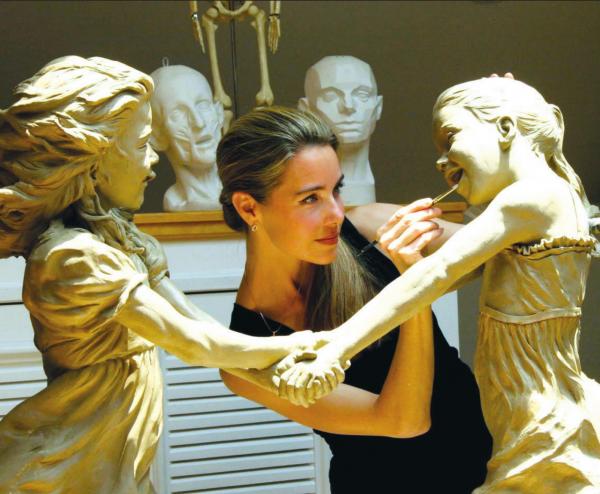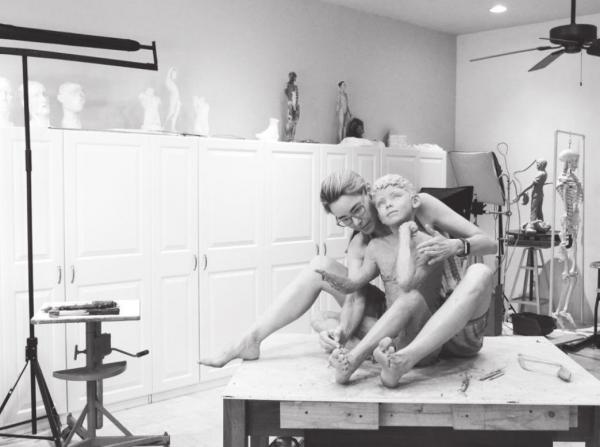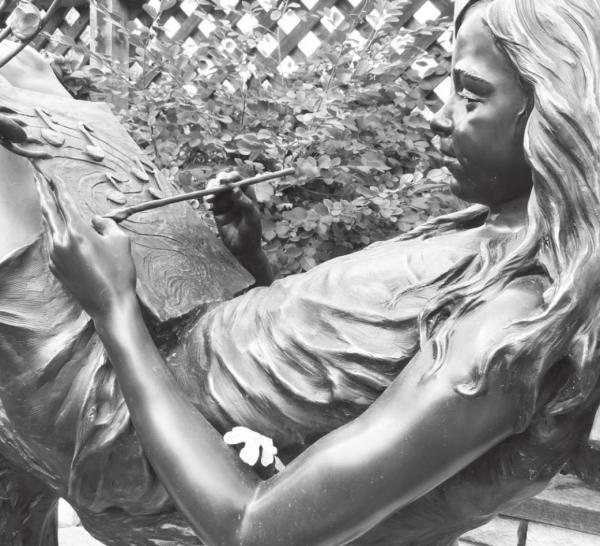Telling the story of Angela Mia De la Vega’s sculpture selected for Martha’s Knies Park
“Love and joy” is the message that international artist Angela Mia De la Vega intends to send out to observers of her realistic bronze sculptures of children and animals. One such bronze in particular, which De la Vega calls “Painting Music,” was purchased by Keep Wimberley Beautiful as a donation soon to reside in the Martha Knies Community Park as its centerpiece.
“I hope every little girl from age one to one hundred sees herself in it,” said De la Vega.
Like many of her sculptures, this piece began as a personal commission for a family’s eleven-year-old girl who loved art, music, and walking in the woods. De la Vega felt a sense of girlhood nostalgia herself, while walking in the forest near her hometown, and so she designed the sculpture with the child sitting in a tree, painting a picture as musical notes emerge from her brush.
“Every sculpture has a story which is nurtured,” De la Vega said. The artist develops a story on the journey of creating an art form, and each art form may awaken an awareness which connects various observers to their own story.
Martha Knies picked out De la Vega’s bronze of this young girl sitting in a tree from Pitzer’s Fine Arts gallery, because it indeed resonated with her childhood. In a short story called, “Gifts from Trees While Growing Up in the Great Depression,” Knies wrote that climbing, hiding, listening, and planning adventures with her sisters in an old Bois d’Arc (Horse Apple) tree in her backyard were truly delightful memories.
“Because of its location in the very back of our yard, it made a great hiding place for me and my two sisters, far enough away from our parents who, we thought, had no idea where we were.”
On the bronze tree, De la Vega sculpted some niches where small wildlife animals peek out. In the niches of the Bois D’Arc Tree, Martha and her sisters stashed dried grapevine sticks and matches to provide that first illicit smoking experience - until giving up the “habit.” Martha could not picture herself as an adult smoking grapevines.
“No sir, this wasn’t going to be my future, so I quit. I never smoked again--not even a real adult cigarette!”
The “Painting Music” piece is viewable at Pitzer’s Fine Arts, until it is installed at Martha’s Park early next year.
De la Vega met Rob and Linda Pitzer in California at their Carmel gallery years ago. She got to know Linda over coffee at a local coffeehouse while in town for a sculpture workshop. Since that time, the Pitzers relocated to Wimberley, establishing a variety of the sculptor’s work at their gallery courtyard on the Wimberley Square.
De la Vega’s home and sculpture studio are currently located in Dallas. She is a solid Texas transplant who was raised in Pennsylvania. After high school, she decided to pursue the medical field at Clarion University of Pennsylvania. Before attending college, she had never been an art student.
“The high school art teacher was simply too teacher was simply too scary,” De la Vega said.
That being said, teachers can inspire or inhibit the progress of children with their influence. Most youth with a creative drive need to be stirred with generous encouragement by an authority figure who offers them respectful attention. This ignites the young person’s eagerness to practice, practice, practice - which sharpens “talent.” The right teacher can be an amazing mentor, and De la Vega found one such art teacher during her sophomore year in college. In response to her newfound passion, Vega’s mother and stepdad pulled out all the stops by further encouraging her to apply for an international arts program in Spain.
“The college of art at the University of Madrid fed my fire 100%,” said De la Vega.
She completed her post graduate studies at the University of Madrid in Spain where she received the international classical training in sculpture and bronze casting that initiated her remarkably successful career.
Her first bronze sold in 1994. Since then she has accomplished over 32 public commissions and installations in Japan, CA, TX, AR, AL,OK, WY, NC, Mexico, and Norway; and successfully competed for awards in over 53 juried shows and museum exhibitions around the country.
Personal commissions are privately collected throughout North America, Europe, Australia, Dubai, India, China, and Japan.
De la Vega is a member of the National Sculpture Society, a Master Signature Member of American Women Artists, and named Living Master by the internationally prestigious Art Renewal Center (ARC). She co-founded FLITE (Friends Lifting Individuals to Empowerment) whose mission is to raise funds to empower enslaved or socially excluded people, including women and kids abused and suppressed.
“As I sculpt, I listen to an enduring memory of my own experiences. Each sculpture begins as dramatic light and shadows over form. Unique details then deliver a responding body that listens as a live face does,” said De la Vega who has also reaped inspiration from watching her own children grow up.
When De la Vega mentors interns and teaches workshops, she advises students not to sacrifice sincerity, and promotes their artistic development without the notion that they must edit their work to conform to another’s viewpoint.
The successful artist works hard. Art is not the result of a magical imagination which effortlessly blooms into existence. Talent is the extension of exerted energy, which hopefully connects us and helps our world to flourish.
What is the process that brings a bronze cast piece such as “Painting Music” to fruition?
MODEL - De la Vega works with live models, taking lots of detailed measurements, photos and angles.
BUILDING ARMATURE - Skeletal framework support of a sculpture is made with aluminum wire, plumbers pipe, or wood; aluminum foil and styrofoam create underlying mass. Clay is added to cover the form.
SCULPTING IN CLAY - Carved to likeness of the model, first in the nude, then clothed.
MAKING THE MOLD - Clay figure is cut up for molding. A coat of liquid silicone is brushed on pieces and dried; other coats are added until an inch thick. A “mother mold” of plaster, fiberglass or plastic is created to sheath the silicone mold for sturdy protection.
WAX - “Mother mold” is opened to remove clay sculpture and closed, and sent to a foundry. Hot wax is poured into mold, then cooled, and hollow wax replica of model is removed.
INVESTMENT PRO CESS - Wax sculpture is dipped with liquid plaster, and submersed into powdered bin of glass or ceramic 6-7 times for two weeks.
BRONZE POURING - Plaster-glass shells are put in a blazing kiln, melting the wax out. Hot shells are removed. Then bronze bricks are melted and molten bronze poured into shells to cool.
METAL WORK - Shells are broken and chiseled from hardened bronze; bronze parts are welded together into whole sculpture; seams ground away; and piece is sandblasted smooth.
PATINA - Bronze sculpture is heated with torch and acids are applied with paintbrush or airbrush to color.
FULL CYCLE - in this pandemic period, with plenty of “shelter at studio” time to work, De la Vega estimates a completed piece takes approximately 6 months. Normally, a sculpture could take much longer due to various outside activities.
Much of the transformation of the sculpture from the wax shell to bronze casting transpires at a foundry. Vega uses foundries in Mexico, Colorado and Oregon, who are familiar with her work and production requirements.
Any readers who have been “creatively stirred” to learn the process, Michael Hall’s Studio Foundry has operated since 1975 nearby in a wooded niche near the historic Texaco on FM150 W in Driftwood, TX.
Martha’s tree story can be found in a book of short stories called “Intimacy With Trees” compiled by Shiila Safer (edited by Shanon Carter).




